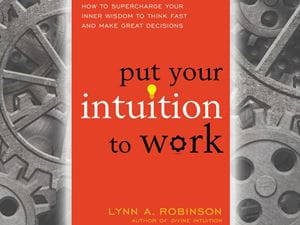
We’ve all had those times when we’ve thought and thought about a decision and just can’t seem to land on the right answer. It’s as if we’re so caught up in logic, facts, and data we can’t see the proverbial trees for the forest. During those periods when you feel stuck, believe that an answer lies within. Ask your intuition for insight and wait for an “aha” moment. It’s your inner wisdom, or intuition, sending you some important insight about how to proceed.
It can feel like you’re getting a text message. It pops into your mind as an insight or concept that wasn’t in your mind a split second before and is now there. These seem to come when you least expect them and usually not when you’re engaged in serious and solemn thought. People report these intuitive ideas often come while they’re in the shower, blow-drying their hair, walking the dog or driving to work.
In my latest book, Put Your Intuition to Work: How to Supercharge Your Inner Wisdom to Think Fast and Make Great Decisions (Career Press, July 2016) I write about the many ways that intuition makes itself known. Here are the five ways to tap into this wisdom within:
Inner Voice
Many people report a "still, quiet, inner voice." Your intuition will always communicate with you in a compassionate, loving manner that is perceptibly different from your normal inner chatter. People often say they wish that quiet voice would turn up the volume a bit! The best way to listen to it is to spend a few minutes every day, simply at rest and listening within. What answers come to you as you sit and reflect?
Dreams
You can receive a wealth of guidance when you learn to ask for intuitive insight from your dreams. Keep a notebook and pen beside your bed. That gives your subconscious mind the idea that you want to remember your dreams. Before going to sleep jot down a paragraph or so about a current concern. Next see if you can summarize this issue as a question or statement. Examples might be, “How could I improve my relationship?” “I need information about the next step in my career.” Or, “What’s my life purpose?” As you drift off to sleep, repeat the question or request. When you awaken, jot down any dreams or dream fragments that you remember. What do they reveal to you about your concern?
Emotions
Intuitive information often comes to you through your feelings or emotion. You may simply “feel right” about a certain course of action. Or you might experience a sense of distrust about an individual or situation. Here’s an easy way to help you make an intuitive decision. When you feel excited, enthusiastic or curious about something, that’s your intuition telling you to move in that direction. It’s informing you to take action on what you’re thinking about. Conversely, if you feel drained, bored or simply uninterested in an idea or activity, that is also your intuition telling you to move away from it or to find a way to make it engaging.
Physical sensations
The Japanese call intuition “stomach art.” We call such sensations a “gut feeling.” Think about a decision you need to make. You might find that your body feels heavy if a decision you’ve made is wrong. Your body may feel light or experience "chills" if it’s the correct path for you. There are many different ways your body may provide clues from your intuition. Think back to a big decision you made in the past. How did you know it was a right (or wrong) answer for you? Your physical system may indicate a “yes” response through a tingly feeling in your arms and head or a “no” response as tightness through your shoulders or chest.
Symbols
Intuition also comes to us in symbolic images. You’ve probably heard the aphorism “A picture is worth a thousand words.” That picture is also one of the ways that intuition communicates its message to you. Bring your current decision to mind and then close your eyes. Ask your intuition for an answer to come to you in an image. For example, you might receive an impression of a rocky road if you choose “Path A.” If you choose the alternative “Path B,” you may see a clear, well-paved path in your mind’s eye.
What can you do to invite this kind of intuitive message? Get clear about what you want and be open to the guidance.
Step 1: What Do You Want?
Here’s a list of work-oriented examples.
I want a winning idea for…
- A there for our annual meeting
- How to grow my business
- Our new ad campaign
- An upcoming job interview
- Boosting sales in our department
Step 2: Chill Out!
What do you enjoy that’s creative and relatively mindless? Do it. For some it’s knitting. For others it might be taking a walk, listening to music, or playing solitaire. You want to create a period of downtime where you’re simply enjoying yourself and not thinking about your problem or concern. Be advised that the message may not pop into your mind during this creative interval, but may happen later on when you least expect it.
Step 3: Listen
Intuitive insights have a distinct feel. Remember the ad campaign for V-8 Juice? The actors had little thought balloons that said, “I could have had a V-8!” Intuition is like that. People often describe them as a “pop” of inspiration or ideas. You can’t force them to happen. You create an environment that allows them to occur.
Within you resides a powerful inner wisdom. It is placed there to guide you through life’s inevitable trials and challenges. Heed its guidance and it will steer you unerringly to peace, happiness and joy. How? Simply be still…and listen.

